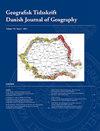Wine trails as organizational pathway toward landscape coherence: the case of the Finger Lakes region, New York, USA
IF 1.1
4区 社会学
Q4 ENVIRONMENTAL STUDIES
Geografisk Tidsskrift-Danish Journal of Geography
Pub Date : 2016-01-02
DOI:10.1080/00167223.2015.1111767
引用次数: 1
Abstract
Abstract This paper explores the role of so-called wine trails as planners and managers of viticultural landscapes, using the case of the Finger Lakes region in New York, USA. Using key informant interviews, it assesses the current capacity and the future potential of these non-governmental, fee-based ‘clubs’ to mediate between global markets and the local agricultural landscape in the absence of policy frameworks designed for this purpose. Though it finds little evidence of such mediation today, the paper argues that the structure and institutional position of wine trails, organizations whose members’ livelihoods depend substantially on long-term landscape coherence, position them to play a more assertive role in doing so in the future, particularly in places marked by lax planning regimes and scarce resources.葡萄酒作为景观一致性的组织路径:以美国纽约芬格湖地区为例
摘要本文以美国纽约芬格湖地区为例,探讨了所谓的葡萄酒小径作为葡萄栽培景观规划者和管理者的作用。通过对关键信息提供者的访谈,它评估了这些非政府的、收费的“俱乐部”在没有为此目的设计的政策框架的情况下,在全球市场和当地农业景观之间进行调解的目前能力和未来潜力。虽然今天没有发现这种调解的证据,但论文认为,葡萄酒之路的结构和制度地位,其成员的生计基本上依赖于长期的景观一致性,使他们在未来发挥更坚定的作用,特别是在规划制度松散和资源稀缺的地方。
本文章由计算机程序翻译,如有差异,请以英文原文为准。
求助全文
约1分钟内获得全文
求助全文
来源期刊
CiteScore
5.20
自引率
0.00%
发文量
5
期刊介绍:
DJG is an interdisciplinary, international journal that publishes peer reviewed research articles on all aspects of geography. Coverage includes such topics as human geography, physical geography, human-environment interactions, Earth Observation, and Geographical Information Science. DJG also welcomes articles which address geographical perspectives of e.g. environmental studies, development studies, planning, landscape ecology and sustainability science. In addition to full-length papers, DJG publishes research notes. The journal has two annual issues. Authors from all parts of the world working within geography or related fields are invited to publish their research in the journal.

 求助内容:
求助内容: 应助结果提醒方式:
应助结果提醒方式:


